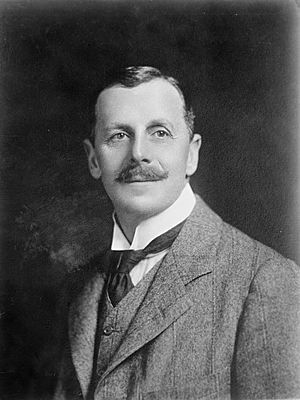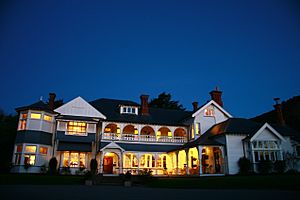Heaton Rhodes facts for kids
Quick facts for kids
Sir Heaton Rhodes
|
|
|---|---|

Heaton Rhodes in 1915
|
|
| Member of the New Zealand Parliament for Ellesmere |
|
| In office 6 December 1899 – 14 October 1925 |
|
| Personal details | |
| Born | 27 February 1861 Purau, Banks Peninsula |
| Died | 30 July 1956 (aged 95) Taitapu, Banks Peninsula |
| Relations | Robert Heaton Rhodes (father) |
Sir Robert Heaton Rhodes (27 February 1861 – 30 July 1956), known as Sir Heaton Rhodes, was an important New Zealand politician and lawyer. He was involved in many areas, from law and military service to politics and even stamp collecting.
Contents
Early Life and Education
Heaton Rhodes was born in Purau, on Banks Peninsula, New Zealand. His father, Robert Heaton Rhodes, was a sheep farmer and also a politician.
Heaton went to school in England at Hereford Cathedral School. After that, he studied at Brasenose College, Oxford, finishing his studies in 1884. In 1887, he became a lawyer, which means he was officially allowed to practice law.
Military Service
After becoming a lawyer, Heaton Rhodes returned to New Zealand. He joined the New Zealand Mounted Rifles Brigade. In 1902, he served in the Second Boer War in South Africa. He was part of the 8th New Zealand group sent to help.
Later, he became a leader in the New Zealand Territorial Force, commanding the 1st Mounted Rifles. Even after he retired from active service, he was given the special title of Honorary Colonel for the 1st Mounted Rifles.
Political Career
Heaton Rhodes had a long career in New Zealand politics. He was elected to the New Zealand House of Representatives, which is like the main parliament. He represented the Ellesmere area from 1899 until 1925. During this time, he joined the Reform Party.
After leaving the House of Representatives in 1925, he was appointed to the New Zealand Legislative Council. This was another part of the government, and he served there until 1941, with a short break.
Government Roles
Heaton Rhodes held several important jobs in the government:
- From 1912 to 1915, he was the Postmaster-General (in charge of postal services) and the Minister for Public Health, Hospitals, and Tourist Resorts.
- During World War I, he became a special Commissioner in Egypt and Galilee. His job was to check on the New Zealand troops serving there.
- In 1916, he moved to Europe to work as the Commissioner for the New Zealand Red Cross, helping with humanitarian efforts.
When he returned to New Zealand in 1920, he was made Minister of Defence. This meant he was in charge of the country's military. In 1922, he also became the Commissioner of State Forests, looking after New Zealand's forests. He held both these roles until 1926.
From 1926 to 1928, he was the Deputy Leader of the Legislative Council. He also served as a minister without a specific department, meaning he helped with various government tasks. In 1927, he was the minister who looked after the Duke and Duchess of York when they visited New Zealand.
He was also involved in community groups, serving as vice-president of the Victoria League for Commonwealth Friendship in Canterbury during the 1930s.
Heaton Rhodes also bred special types of cattle at his home, Otahuna, near Tai Tapu. He was also known for growing many beautiful daffodils there.
Stamp Collecting (Philately)
Heaton Rhodes was a very keen philatelist, which is someone who collects and studies postage stamps. He had a very large collection of New Zealand's old "Chalon head" postage stamps.
He was the President of the Royal Philatelic Society of New Zealand. In 1949, he was honored by signing the Roll of Distinguished Philatelists, a special list for the most important stamp collectors in the world.
Awards and Honours
Heaton Rhodes received several important awards for his service:
- In 1920, he was made a Knight Commander of the Order of the British Empire (KBE). This was for his work as the commissioner of the New Zealand Red Cross during the war.
- In 1927, he was appointed a Knight Commander of the Royal Victorian Order (KCVO). This award was given to him for his role in looking after the Duke and Duchess of York during their visit to New Zealand.
- He also received the King George V Silver Jubilee Medal in 1935.
He also received awards from other countries:
He was a Commander of the Order of the British Empire from Great Britain.
 He was a Chevalier (Knight) of the Légion d'Honneur from France.
He was a Chevalier (Knight) of the Légion d'Honneur from France.


